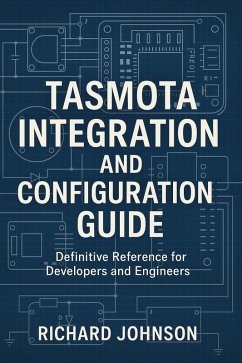
Camel Integration Patterns and Practices (eBook, ePUB)
Definitive Reference for Developers and Engineers

PAYBACK Punkte
0 °P sammeln!
"Camel Integration Patterns and Practices" "Camel Integration Patterns and Practices" presents a comprehensive, expertly structured guide for architects and developers seeking to design, implement, and maintain robust enterprise integrations using Apache Camel. The book begins by laying a strong foundation in the challenges of enterprise integration, explaining Apache Camel's flexible architecture, versatile messaging models, and supported configuration options. Readers are introduced to the intricacies of Camel's component model and discover best practices for deploying scalable integration f...
"Camel Integration Patterns and Practices" "Camel Integration Patterns and Practices" presents a comprehensive, expertly structured guide for architects and developers seeking to design, implement, and maintain robust enterprise integrations using Apache Camel. The book begins by laying a strong foundation in the challenges of enterprise integration, explaining Apache Camel's flexible architecture, versatile messaging models, and supported configuration options. Readers are introduced to the intricacies of Camel's component model and discover best practices for deploying scalable integration flows across a range of architectures, including clustered and microservices topologies. Delving deeper, the book systematically explores a wide spectrum of enterprise integration patterns and their practical realization in Camel-from sophisticated message routing, transformation, and endpoint communication, to transactional routing, idempotency, and resilient error-handling strategies. Readers are further empowered with advanced techniques for dynamic route design, custom processors, monitoring, and instrumenting integration flows, as well as integrating with diverse protocols, databases, messaging systems, cloud platforms, IoT networks, and SaaS applications. The text also addresses data transformation, quality, and validation, equipping professionals to handle complex mapping, streaming, and schema enforcement challenges with confidence. To ensure secure, compliant, and high-quality integrations, the book provides thorough coverage of security mechanisms, auditability, policy enforcement, and vulnerability management. Testing and lifecycle management are presented through modern DevOps practices, including automated testing, CI/CD, and versioned route management. The final chapters bring theory to life with industry-proven use cases and cloud-native deployment patterns, highlighting real-world architectures across financial services, healthcare, retail, IoT, telecom, legacy modernization, and cloud-to-cloud integrations. This authoritative reference is essential reading for practitioners aspiring to master Camel and modern enterprise integration.
Dieser Download kann aus rechtlichen Gründen nur mit Rechnungsadresse in A, B, BG, CY, CZ, D, DK, EW, E, FIN, F, GR, H, IRL, I, LT, L, LR, M, NL, PL, P, R, S, SLO, SK ausgeliefert werden.













